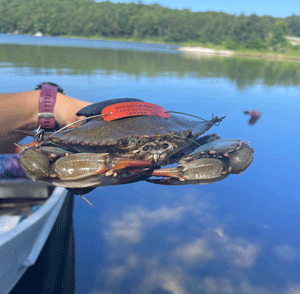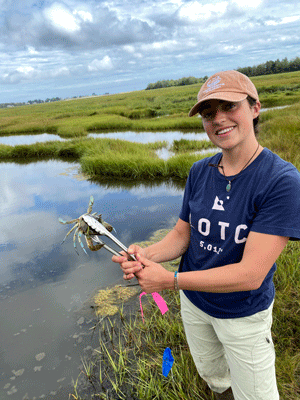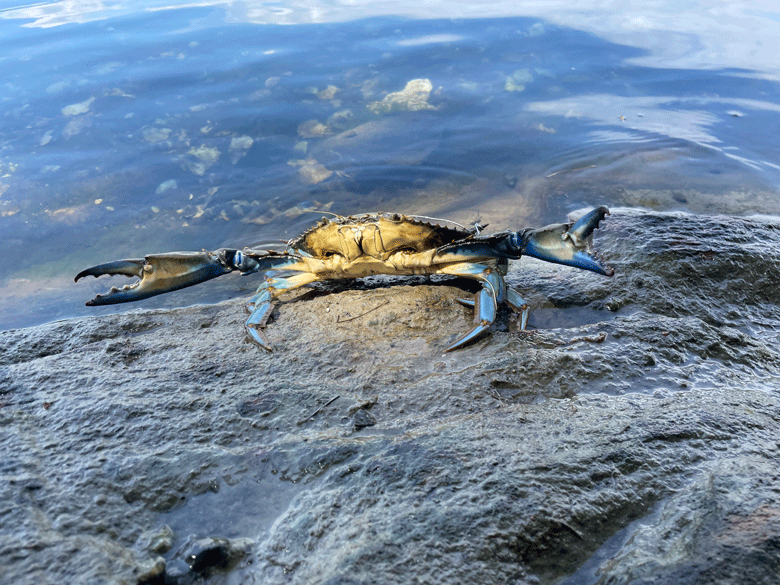
Blue crabs are expanding their range into the warming waters of the Gulf of Maine, raising questions about their long-term impact on other marine species and whether they could become a commercial fishery in the years or decades ahead.
Blue crabs are commonly found in warmer waters south of Cape Cod and are harvested commercially from New Jersey to the Gulf of Mexico. But they have been showing up in salt marshes, in lobster traps, on clam flats, and elsewhere in Maine the past few years from Kittery to as far east as Mount Desert Island—and their numbers are growing.
Through late October of this year, people have reported seeing more than 120 blue crabs through an online reporting survey set up by Manomet, a Massachusetts-based conservation and science nonprofit. Manomet has also trapped close to 50 blue crabs this year in Casco Bay’s New Meadows River. At the same time, the Wells National Estuarine Research Reserve has caught more than 220 of the crabs in its traps in salt marshes this year, a sharp increase from the previous few years.
“We’re starting to see females carrying eggs, we’re seeing blue crabs mating…”
—Jessie Batchelder
Those numbers are small, but they represent only a tiny fraction of the total number of blue crabs now living in the Gulf of Maine as water temperatures continue their upward climb. The warming waters are allowing the crabs to take hold in the Gulf of Maine, which stretches from Cape Cod to Nova Scotia, said Jessie Batchelder, a fisheries project manager with Manomet who works out of the organization’s Maine office in Brunswick.
“Warming waters are allowing them to survive further north,” she said. “And we’re starting to see females carrying eggs, we’re seeing blue crabs mating, there are reports of larval blue crabs. So we know we’re finding all stages of blue crabs at this point.”

The crabs started showing up with regularity in 2020 in wire-mesh traps that were set by the Wells Reserve to monitor salt water marshes in Southern Maine. For the first three years, between 20 and 50 crabs were caught in the traps each year, from April into November.
“Then this year, we blew it out of the park,” said Laura Crane, a research associate at the Wells Reserve. “We’ve caught more than 220 blue crabs and we’re not done trapping.”
In the U.S., blue crabs live along the Atlantic Coast and in the Gulf of Mexico and are caught by both commercial and recreational fishermen. Its scientific name—Callinectes sapidus—means “beautiful savory swimmer” in Latin.
Prized for its sweet flavor and tender meat, the blue crab is a valuable commercial fishery. In 2022, U.S. fishermen harvested 115 million pounds valued at $220 million, according to NOAA Fisheries. Fishermen in Virginia and Maryland, who catch crabs in Chesapeake Bay, caught 32.6 million pounds, but Louisiana had the biggest harvest at nearly 50 million pounds.
In the wild, blue crabs are eaten by large fish, some fish-eating birds, and sea turtles, according to NOAA Fisheries. But it’s what crabs themselves eat that is raising questions in the Gulf of Maine.
Blue crabs are major predators of ocean-bottom communities and will eat almost anything, including clams, oysters, mussels, small crustaceans, freshly dead fish, and plants. They’ll also eat smaller and soft-shelled blue crabs.
In Maine, one question is whether blue crabs pose a threat to juvenile lobsters that are abundant and serve as the foundation of Maine’s lobster fishery. “Blue crabs are one of the most aggressive crab species and pose predatory and habitat threats to lobsters,” said Aaron Whitman, a senior research associate at the Gulf of Maine Research Institute in Portland.
Conversely, will they eat invasive green crabs that feast on juvenile clams and have decimated the clam population in some parts of Maine? Blue crabs have been credited with keeping the green crab population in check in the Chesapeake Bay.

Scientists are also watching to see whether the blue crabs will establish themselves and grow to the point where they could become a fishery of their own. But that would likely be far in the future if it were to happen at all.
Brandon Henry, a University of Maine doctoral student studying the expanding range of blue crabs in the Gulf of Maine, said blue crabs have appeared in Maine in decades past, only to disappear a few years later.
Between 1948 and 1956, for instance, numerous blue crabs were caught in Maine waters, according to an article published in 1960 in the Maine Field Naturalist scientific research journal. The article, written by a marine biologist with the U.S. Fish and Wildlife Service Bureau of Commercial Fisheries, said lobstermen and lobster dealers reported hundreds of blue crabs showing up yearly, primarily from the Portsmouth, N.H.-Kittery area up to Casco Bay. The reason? Warmer waters.
During those years, the water temperatures were far above their average, the journal reported. But when temperatures reverted to their long-time norm, the crabs left.
The crabs could be here to stay this time given the steady rise in water temperatures over the past 40 years. The Gulf of Maine is one of the fastest-warming ocean regions on Earth.
“We’re unsure of how far up into Maine they’ll expand,” Henry said. “They are salt marsh specialists, that’s the habitat they prefer living in, so we are uncertain if they would be able to go up into the more northern areas of Maine on account of the shores there are more rocky and don’t have the salt marsh environment they live in typically.”
In response to the growing blue crab population, Crane last year formed the Gulf of Maine Blue Crab Network to help facilitate collaborative research on blue crabs. Among the 30-40 participants are the Wells Reserve, Manomet, the University of Maine, the University of New Hampshire, the Great Bay National Estuarine Research Reserve, and the Gulf of Maine Research Institute.
Have you seen a blue crab in the Gulf of Maine? To report a sighting, or see where blue crabs have been found, visit: www.manomet.org/bluecrab/





